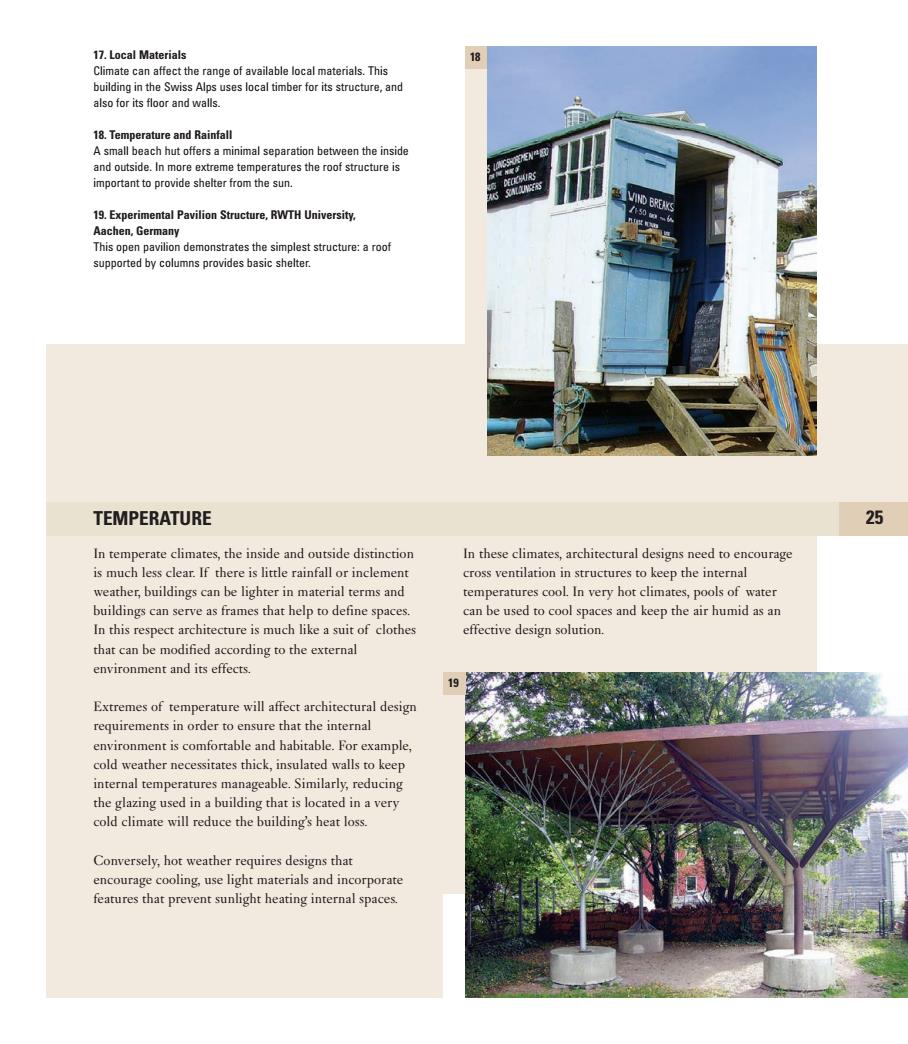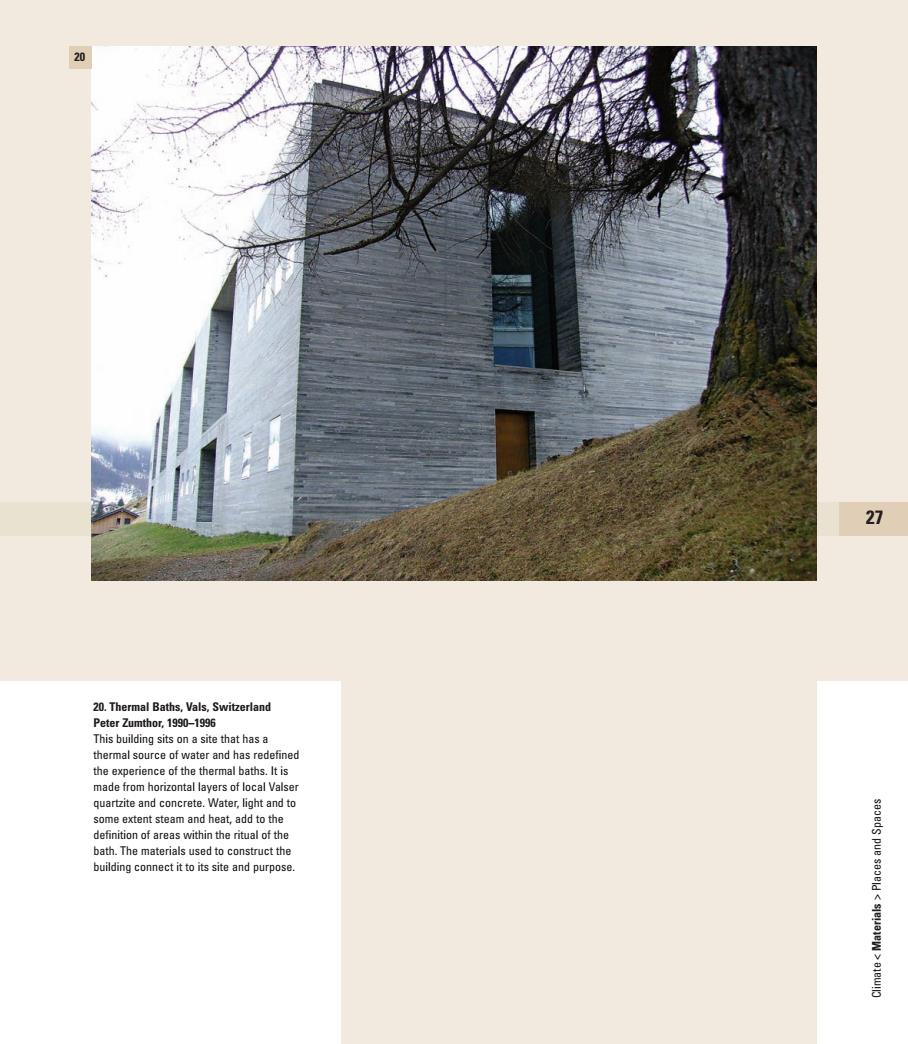
13 14 23 15 16 里武 13.,14.,15.16.Position and Light 13.External louvres on a building can modify the light coming into the building and can be manually adjusted to control the light. 14.Shadows cast by structures can have an impact on their surrounding environment,creating a local climate of light and dark. 15.Internal shadow can dramatically affect the way an interior environment may feel.Architects can play with light to create different moods within buildings. 16.Understanding that sunlight entering a building will change over the course of the day or will vary from season to season informs the design and layout of the interior spaces
p23 QC Preflight Point 2nd 11 11 Job no : 76451 Title : The Fundamentals of Architecture Client : AVA Scn : #175 Size : 200(w)230(h)mm Co : M11 C0 (All To Spot)(Coagl)__LC Dept : DTP D/O : 07.05.07 (Job no: 76451C1 D/O : 25.05.07 Co: CM3) 76451_CTP_001-051.qxd 5/23/07 5:05 AM Page 23 p23 2nd 14 23 13., 14., 15. & 16. Position and Light 13. External louvres on a building can modify the light coming into the building and can be manually adjusted to control the light. 14. Shadows cast by structures can have an impact on their surrounding environment, creating a local climate of light and dark. 15. Internal shadow can dramatically affect the way an interior environment may feel. Architects can play with light to create different moods within buildings. 16. Understanding that sunlight entering a building will change over the course of the day or will vary from season to season informs the design and layout of the interior spaces. Site < Orientation > Climate 13 15 16 76451_CTP_001-051.qxd 5/23/07 5:05 AM Page 23

Climate Climate is a key contributing factor to the specific nature of site,and climatic variations influence many factors associated with architecture.Buildings will serve as a moderator from the inside to outside. 17 24 RAINFALL There are numerous examples of site responses that are driven by climate,perhaps because there is a desire to control or modify it,or perhaps to use local resources that climatic conditions have created. Climate affects temperature ranges and rainfall.In inclement climates Bujoeld there is clear distinction between the interior and exterior of a building.Rain will need to be prevented from entering buildings and all architecture has to be waterproof.To satisfy this requirement buildings have gutters and pipes and roofs that slope at particular angles to take the rainwater away efficiently and effectively,and these will affect the form and appearance of the architecture. 瞿
QC Preflight Point 1st 11 11 p24 Job no : 76451 Title : The Fundamentals of Architecture Client : AVA Scn : #175 Size : 200(w)230(h)mm Co : M11 C0 (All To Spot)(Coagl)__LC Dept : DTP D/O : 07.05.07 (Job no:000000 D/O : 00.00.07 Co: CM0) J S D 74561_CTP_001-051.qxd 5/3/07 11:01 AM Page 24 1st p24 24Placing Architecture The Fundamentals of Architecture RAINFALL There are numerous examples of site responses that are driven by climate, perhaps because there is a desire to control or modify it, or perhaps to use local resources that climatic conditions have created. Climate affects temperature ranges and rainfall. In inclement climates there is clear distinction between the interior and exterior of a building. Rain will need to be prevented from entering buildings and all architecture has to be waterproof. To satisfy this requirement buildings have gutters and pipes and roofs that slope at particular angles to take the rainwater away efficiently and effectively, and these will affect the form and appearance of the architecture. Climate Climate is a key contributing factor to the specific nature of site, and climatic variations influence many factors associated with architecture. Buildings will serve as a moderator from the inside to outside. 17 74561_CTP_001-051.qxd 5/3/07 11:01 AM Page 24

17.Local Materials 18 Climate can affect the range of available local materials.This building in the Swiss Alps uses local timber for its structure,and also for its floor and walls. 18.Temperature and Rainfall A small beach hut offers a minimal separation between the inside and outside.In more extreme temperatures the roof structure is important to provide shelter from the sun. VIND BREAKS 19.Experimental Pavilion Structure,RWTH University. Aachen,Germany This open pavilion demonstrates the simplest structure:a roof supported by columns provides basic shelter. TEMPERATURE 25 In temperate climates,the inside and outside distinction In these climates,architectural designs need to encourage is much less clear.If there is little rainfall or inclement cross ventilation in structures to keep the internal weather,buildings can be lighter in material terms and temperatures cool.In very hot climates,pools of water buildings can serve as frames that help to define spaces. can be used to cool spaces and keep the air humid as an In this respect architecture is much like a suit of clothes effective design solution. that can be modified according to the external environment and its effects. Extremes of temperature will affect architectural design requirements in order to ensure that the internal environment is comfortable and habitable.For example, cold weather necessitates thick,insulated walls to keep internal temperatures manageable.Similarly,reducing the glazing used in a building that is located in a very cold climate will reduce the building's heat loss. Conversely,hot weather requires designs that encourage cooling,use light materials and incorporate features that prevent sunlight heating internal spaces
p25 QC Preflight Point 2nd 11 11 Job no : 76451 Title : The Fundamentals of Architecture Client : AVA Scn : #175 Size : 200(w)230(h)mm Co : M11 C0 (All To Spot)(Coagl)__LC Dept : DTP D/O : 07.05.07 (Job no: 76451C1 D/O : 25.05.07 Co: CM11) 76451_CTP_001-051.qxd 5/23/07 9:11 AM Page 25 p25 18 25 17. Local Materials Climate can affect the range of available local materials. This building in the Swiss Alps uses local timber for its structure, and also for its floor and walls. 18. Temperature and Rainfall A small beach hut offers a minimal separation between the inside and outside. In more extreme temperatures the roof structure is important to provide shelter from the sun. 19. Experimental Pavilion Structure, RWTH University, Aachen, Germany This open pavilion demonstrates the simplest structure: a roof supported by columns provides basic shelter. TEMPERATURE In temperate climates, the inside and outside distinction is much less clear. If there is little rainfall or inclement weather, buildings can be lighter in material terms and buildings can serve as frames that help to define spaces. In this respect architecture is much like a suit of clothes that can be modified according to the external environment and its effects. Extremes of temperature will affect architectural design requirements in order to ensure that the internal environment is comfortable and habitable. For example, cold weather necessitates thick, insulated walls to keep internal temperatures manageable. Similarly, reducing the glazing used in a building that is located in a very cold climate will reduce the building’s heat loss. Conversely, hot weather requires designs that encourage cooling, use light materials and incorporate features that prevent sunlight heating internal spaces. In these climates, architectural designs need to encourage cross ventilation in structures to keep the internal temperatures cool. In very hot climates, pools of water can be used to cool spaces and keep the air humid as an effective design solution. 19 2nd 76451_CTP_001-051.qxd 5/23/07 9:11 AM Page 25

Materials The palette of materials chosen for a building will collectively paint an impression of it.Choosing this palette of materials relies on a clear understanding of the site.Each site,whether urban or landscape, has an intrinsic materiality. 26 LOCALITY Historically,the choice of materials at an architect's disposal would have been restricted by local availability and modes of available transportation to the site. Therefore,architecture would have been constructed from materials from the locality,stones sourced from a local quarry,bricks made from local clay,thatch produced from fields surrounding the site and so on.These buildings were literally made from the earth around them and as such they looked like they were part of the landscape of the area.As materials have become more widely available,this palette has expanded. Buyoeld Materials used in architectural forms no longer have to have this strong connection to their place of origin,they can be moved easily from location to location,resulting in responses that are much more varied and eclectic.The development of materials such as concrete have created endless possibilities in terms of architectural form,as this is a construction material that is universally adaptable and applicable.It has opened up the potential opportunity for ground-breaking architectural design and form making
QC Preflight Point 1st 11 11 p26 Job no : 76451 Title : The Fundamentals of Architecture Client : AVA Scn : #175 Size : 200(w)230(h)mm Co : M11 C0 (All To Spot)(Coagl)__LC Dept : DTP D/O : 07.05.07 (Job no:000000 D/O : 00.00.07 Co: CM0) 74561_CTP_001-051.qxd 5/3/07 11:01 AM Page 26 1st p26 26Placing Architecture The Fundamentals of Architecture Materials The palette of materials chosen for a building will collectively paint an impression of it. Choosing this palette of materials relies on a clear understanding of the site. Each site, whether urban or landscape, has an intrinsic materiality. LOCALITY Historically, the choice of materials at an architect’s disposal would have been restricted by local availability and modes of available transportation to the site. Therefore, architecture would have been constructed from materials from the locality, stones sourced from a local quarry, bricks made from local clay, thatch produced from fields surrounding the site and so on. These buildings were literally made from the earth around them and as such they looked like they were part of the landscape of the area. As materials have become more widely available, this palette has expanded. Materials used in architectural forms no longer have to have this strong connection to their place of origin, they can be moved easily from location to location, resulting in responses that are much more varied and eclectic. The development of materials such as concrete have created endless possibilities in terms of architectural form, as this is a construction material that is universally adaptable and applicable. It has opened up the potential opportunity for ground-breaking architectural design and form making. 74561_CTP_001-051.qxd 5/3/07 11:01 AM Page 26

20 27 20.Thermal Baths,Vals,Switzerland Peter Zumthor,1990-1996 This building sits on a site that has a thermal source of water and has redefined the experience of the thermal baths.It is made from horizontal layers of local Valser quartzite and concrete.Water,light and to some extent steam and heat,add to the definition of areas within the ritual of the bath.The materials used to construct the building connect it to its site and purpose
p27 QC Preflight Point 2nd 11 11 Job no : 76451 Title : The Fundamentals of Architecture Client : AVA Scn : #175 Size : 200(w)230(h)mm Co : M11 C0 (All To Spot)(Coagl)__LC Dept : DTP D/O : 07.05.07 (Job no: 76451C1 D/O : 25.05.07 Co: CM3) 76451_CTP_001-051.qxd 5/23/07 5:06 AM Page 27 p27 2nd 27 20. Thermal Baths, Vals, Switzerland Peter Zumthor, 1990–1996 This building sits on a site that has a thermal source of water and has redefined the experience of the thermal baths. It is made from horizontal layers of local Valser quartzite and concrete. Water, light and to some extent steam and heat, add to the definition of areas within the ritual of the bath. The materials used to construct the building connect it to its site and purpose. Climate < Materials > Places and Spaces 20 76451_CTP_001-051.qxd 5/23/07 5:06 AM Page 27